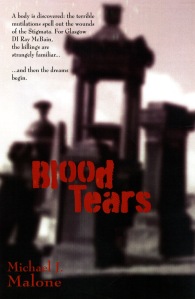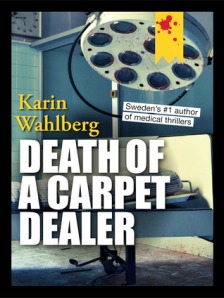
Blood Tears
by Michael J Malone
Five Leaves Publications, 2012
Kindle edition
DI Ray McBain of the Glasgow police and his team are celebrating the successful outcome of a murder case: before a day has passed, however, another murder is committed and the team swings into action again. An elderly man has been killed by someone who has inflicted wounds similar to the stigmata on his (or her) victim.
Tasks are divided up, and McBain with his young colleague Alessandra Rossi go to a Catholic care home where the victim worked as a caretaker. McBain is overwhelmed by emotion during his and Rossi’s interview with the mother superior. It turns out that McBain himself grew up in the home and that he suffered cruelty and abuse while there. While the two cops are copying out the names of children who were at the home while the victim was employed there, McBain persuades Rossi to leave his own name off the list, on the grounds that he’ll be taken off the investigation if it is known that he has a connection with it.
The first half of the book continues in a standard police procedural vein, but McBain’s behaviour becomes increasingly erratic. He gets drunk a lot, insults people, picks up random women and attempts to sleep with them, pukes up everywhere, eats little but deep-fried pizza, and so on. He suffers from terrible dreams, and is convinced that he is somehow connected to the case, if only he can remember how or why.
Events then take a sharp turn, and McBain finds himself a fugitive from the law. He is helped by his only friend, a local criminal who he has helped a couple of times in the past, and by two of his colleagues, who keep him up to date with the investigation. Will McBain be able to solve the case before he is caught?
Blood Tears is a quick and easy read, but I found the main character hard to like, despite the traumas he had suffered in his past. The second part of the book seems particularly unrealistic, as McBain hangs around in a local hotel doing nothing for a month apart from getting fit and drying out, before swinging into action and attempting to follow up some leads. As he does so, the dreams intensify and the reader is given a few more italic “mind of the killer” sections. The ending, when all is revealed, seemed a little flat. There are some engaging elements in the book, in particular the dynamics at the police station in the first half (as well as the underdeveloped character of Rossi), but the second half suffers from these being dropped. The subject matter of abuse in religious and other institutions is a harrowing and awful one. Although this book is perfectly sincere in its portrayal of this sensitive issue, I do not think it provides any further insight in comparison to previous treatments.
I downloaded this book as a free promotion. I thank Rob and Sarah for recommending it. Their reviews of it are at The View from The Blue House and Crimepieces, respectively.
Other reviews of the book are at: Crimesquad, Ric’s Reviews and Undiscovered Scotland (plus a very large number at Amazon UK). 






















